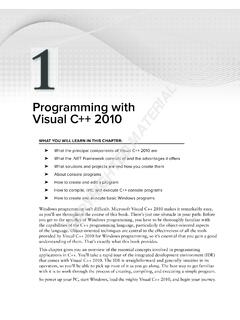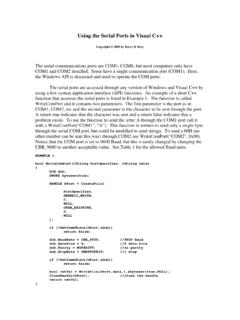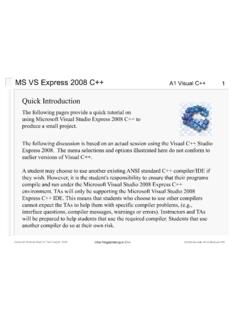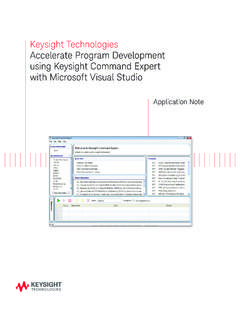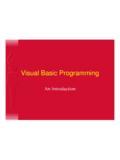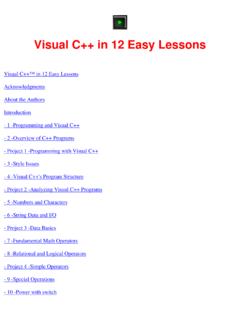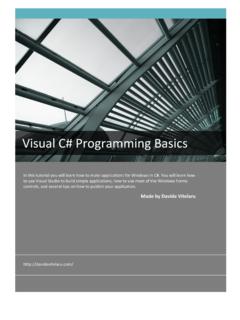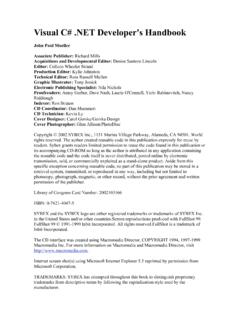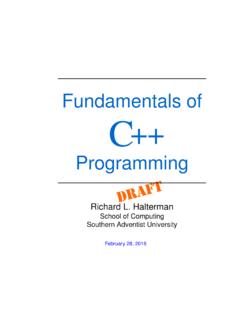Transcription of Microsoft Visual C++/CLI Step by Step - pearsoncmg.com
1 Microsoft Visual C++/CLI step by StepJulian TemplemanCopyright 2013 by Julian TemplemanAll rights reserved. No part of the contents of this book may be reproduced or transmitted in any form or by any means without the written permission of the : 978-0-7356-7517-91 2 3 4 5 6 7 8 9 LSI 8 7 6 5 4 3 Printed and bound in the United States of Press books are available through booksellers and distributors worldwide. If you need support related to this book, email Microsoft Press Book Support at Please tell us what you think of this book at Microsoft and the trademarks listed at are trademarks of the Microsoft group of companies. All other marks are property of their respective example companies, organizations, products, domain names, email addresses, logos, people, places, and events depicted herein are fictitious.
2 No association with any real company, organization, product, domain name, email address, logo, person, place, or event is intended or should be book expresses the author s views and opinions. The information contained in this book is provided without any express, statutory, or implied warranties. Neither the authors, Microsoft Corporation, nor its resellers, or distributors will be held liable for any damages caused or alleged to be caused either directly or indirectly by this and Developmental Editor: Russell JonesProduction Editor: Kara EbrahimTechnical Reviewer: Luca RegnicoliCopyeditor: Octal Publishing, : BIM Indexing and Proofreading ServicesCover Design: Twist Creative SeattleCover Composition: Ellie VolckhausenIllustrator: Rebecca DemarestI would like to dedicate this book to my wife, Jane, without whose steadfast love and support none of this would be possible.
3 Julian TemplemanContents at a GlanceIntroduction xxiPART I GETTING STARTED WITH C++ .NETChapTer 1 hello C++! 3 ChapTer 2 Introducing object-oriented programming 13 ChapTer 3 Variables and operators 23 ChapTer 4 Using functions 37 ChapTer 5 Decision and loop statements 57 ChapTer 6 More about classes and objects 77 ChapTer 7 Controlling object lifetimes 103 ChapTer 8 Inheritance 121 PART II Microsoft .NET PROGRAMMING BASICSChapTer 9 Value types 143 ChapTer 10 Operator overloading 159 ChapTer 11 exception handling 175 ChapTer 12 arrays and collections 197 ChapTer 13 properties 229 ChapTer 14 Delegates and events 245 ChapTer 15 The.
4 NeT Framework class library 263 PART III USING THE .NET FRAMEWORKChapTer 16 Working with files 281 ChapTer 17 reading and writing XML 305 ChapTer 18 Using 333 ChapTer 19 Writing a service by using Windows Communication Foundation 351 ChapTer 20 Introducing Windows Store apps 369 ChapTer 21 More about Windows Store apps 397vi Contents at a GlancePART IV ADVANCED TOPICSChapTer 22 Working with unmanaged code 437 ChapTer 23 Attributes and reflection 453 ChapTer 24 Living with COM 475 Index 487
5 ViiContentsIntroduction ..xxiPART I GETTING STARTED WITH C++ .NETC hapter 1 Hello C++! 3 What is C++/CLI ? ..3 Your first C++/CLI application ..4 The main function ..4C++ keywords and identifiers ..5 Creating an executable application theory ..6 Editing the application source files ..6 Compiling the source files ..6 Running and testing the application ..7 Creating an executable application practice..7 Creating a project ..8 Editing the C++ source code ..9 Building the executable ..9 Executing the application.
6 11 Conclusion ..11 Quick reference ..11 Chapter 2 Introducing object-oriented programming 13 What is object-oriented programming? ..13 Features of object-oriented programming languages ..14 Encapsulation ..14 Inheritance ..15 Polymorphism ..15 Classes and objects ..16viii ContentsBenefits to the development life cycle ..16A simple example ..17 Quick reference ..22 Chapter 3 Variables and operators 23 What is a variable? ..23 The fundamental data types ..23 Declaring a variable ..25 Variable naming ..25 Declaring multiple variables ..26 Assigning values to variables ..26 Handles and pointers ..27 Arrays ..28 Constants ..28 Typedefs ..29 The .NET Framework String class ..29 Operators and expressions.
7 30 Assignment operators ..30 Arithmetic operators ..30 Relational and logical operators ..31 Bitwise operators ..32 The ternary operator ..33 Type casting ..33 Operator precedence and associativity ..34 Quick reference ..35 Chapter 4 Using functions 37 Declaring function prototypes ..38 Declaring a simple function prototype ..38 Declaring parameters in a function prototype ..39 Declaring the return type in a function prototype ..39 Declaring default values for function parameters ..40 Contents ixDefining function bodies.
8 41 Calling functions ..45 Stepping through the application by using debugger ..47 Understanding local and global scope ..51 Quick reference ..55 Chapter 5 Decision and loop statements 57 Making decisions by using the if statement ..57 Performing one-way tests ..57 Performing two-way tests ..61 Performing multiway tests ..62 Performing nested tests ..64 Making decisions by using the switch Statement ..65 Defining simple switch statements ..65 Using fall-through in a switch statement ..67 Performing loops ..68 Using while loops ..68 Using for loops ..70 Using do-while loops ..71 Performing unconditional jumps ..73 Quick reference ..75 Chapter 6 More about classes and objects 77 Organizing classes into header files and source files.
9 78 Declaring a class in a header file ..79 Implementing a class in a source file ..81 Creating objects ..83 Initializing objects by using constructors ..84 Defining constructors ..84 Member initialization lists ..86 Defining class-wide members ..87 Defining class-wide data members ..88 Defining class-wide member functions ..90 Class constructors ..92x ContentsUsing constants in classes ..93 Using class-wide constants ..93 Using instance constants ..94 Defining object relationships ..95 Defining the LoyaltyScheme Class ..95 Implementing the LoyaltyScheme class ..96 Creating and using LoyaltyScheme objects ..97 Testing the application ..100 Quick reference ..101 Chapter 7 Controlling object lifetimes 103 The.
10 NET approach to object lifetimes ..103 Destruction and finalization ..105 Destructors ..105 Finalizers ..106 Implementing the destructor and finalizer for a class ..107 Objects and stack semantics ..110 Copy constructors ..113 Relating objects with stack semantics ..116 Quick reference ..119 Chapter 8 Inheritance 121 What is inheritance? ..121 Inheritance terminology ..122 Inheritance and code reuse ..122 Designing an inheritance hierarchy ..123A word on substitutability ..123 Defining a base class ..124 Defining a derived class ..126 Creating derived class objects ..129 Concrete and abstract classes ..130 Overriding member functions.










